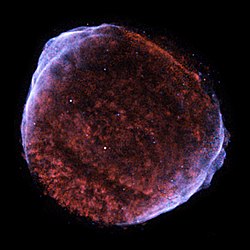SN 1006

SN 1006 supernova remnant
|
|
| Other designations | SN 1006, SN 1006A, SN 1016, SNR G327.6+14.6, SNR G327.6+14.5, 1ES 1500-41.5 |
|---|---|
| Event type |
Supernova, supernova remnant |
| Spectral class | Type Ia (presumably) |
| Observation | |
| Date | 17 April 1006 to 1 May 1006 |
| Location | |
| Constellation | Lupus |
| Right ascension | 15h 2m 8s |
| Declination | −41° 57′ |
| Epoch | 2000 |
| Galactic coordinates | 327.6+14.6 |
| Distance | 7,200 light-years (2.2 kpc) |
| Remnant | Shell |
| Host | Milky Way |
| Characteristics | |
| Progenitor | Unknown |
| Progenitor type | Unknown |
| Colour (B-V) | Japanese observers describe as blue-white at visible spectrum |
| Notable features | Brightest supernova in recorded history, and therefore most described of the pretelescopic era |
| Energetics | |
| Peak apparent magnitude | −7.5 |
| See also | |
| Preceded by | SN 393 |
| Followed by | SN 1054 |
|
[]
|
|
SN 1006 was a supernova that is likely the brightest observed stellar event in recorded history, reaching an estimated −7.5 visual magnitude, and exceeding roughly sixteen times the brightness of Venus. Appearing between April 30 and May 1, 1006 AD in the constellation of Lupus, this "guest star" was described by observers across China, Japan, Iraq, Egypt, and Europe, and possibly recorded in North American petroglyphs. Some reports state it was clearly visible in the daytime. Modern astronomers now consider its distance from us at about 7,200 light-years.
Egyptian astrologer and astronomer Ali ibn Ridwan, writing in a commentary on Ptolemy's Tetrabiblos, stated that the "spectacle was a large circular body, 2½ to 3 times as large as Venus. The sky was shining because of its light. The intensity of its light was a little more than a quarter that of Moon light" (or perhaps "than the light of the Moon when one-quarter illuminated"). Like all other observers, Ali ibn Ridwan noted that the new star was low on the southern horizon. Some astrologers interpreted the event as a portent of plague and famine.
The most northerly sighting is recorded in the annals [1] of the Abbey of Saint Gall in Switzerland, at a latitude of 47.5° North. Monks at St Gall provide independent data as to its magnitude and location in the sky, writing that "[i]n a wonderful manner this was sometimes contracted, sometimes diffused, and moreover sometimes extinguished… It was seen likewise for three months in the inmost limits of the south, beyond all the constellations which are seen in the sky". This description is often taken as probable evidence that the supernova was of Type Ia.
Some sources state that the star was bright enough to cast shadows; it was certainly seen during daylight hours for some time.
According to Songshi, the official history of the Song Dynasty (sections 56 and 461), the star seen on 1 May 1006 appeared to the south of constellation Di, east of Lupus and one degree to the west of Centaurus. It shone so brightly that objects on the ground could be seen at night.
...
Wikipedia
